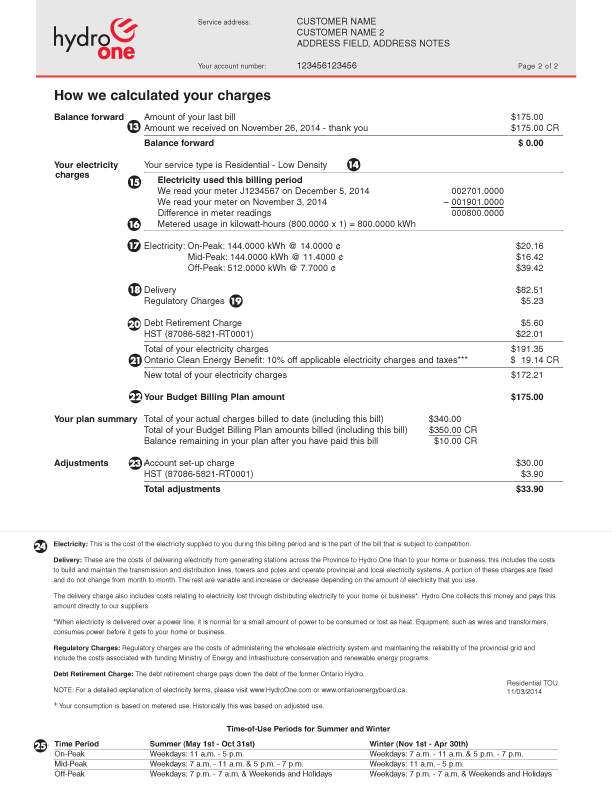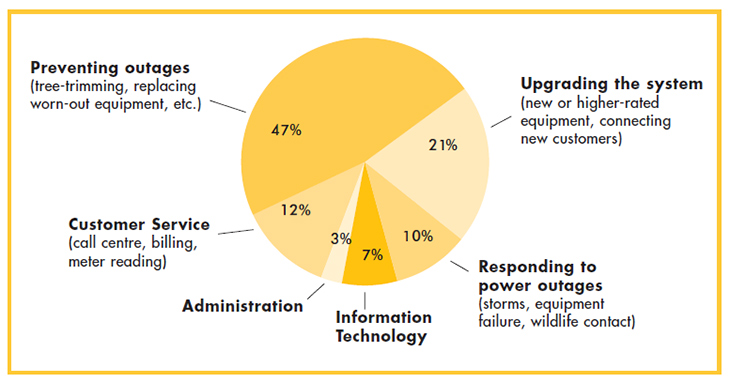When it comes to reading your hydro bills, it’s important to understand what’s actually being said. But it’s equally important to figure out what’s left unsaid. Your hydro bill might do a good job of breaking down the different components you’re paying for, but it doesn’t waste paper explaining what goes on behind the scenes. If you want to learn this part of the story, you need to dig a little deeper. And that’s what we’re going to do in this blog.
In the first two parts of this series “Your Hydro Bill Explained”, we presented the TOU (Time of Use) rates for electricity in Ontario and broke down the basics of calculating energy usage for appliances in kWh. Hopefully this discussion was able to help you understand the fundamental costs that your home incurs on a daily basis.
In this next blog, we’d like to walk you through the next couple of lines on your hydro bill. These lines are the delivery charge and the regulatory charge. You can see where they fit on the sample bill on lines 18 and 19. Hydro One even offers a simple explanation on the bill statement (click the image below for a closer look). Basically, the delivery charge is just what it sounds like—it’s what you pay the hydro company to deliver electricity to your doorstep.
But why does it cost so much?

Your Location
We’ve all seen those massive hydro towers, and most of us know first-hand what happens when there’s an ice storm or a tree falls in the wrong place. Building and maintaining transmission systems isn’t cheap or easy. These costs are a big portion of the delivery rates. The pie chart below (from the Hydro One website), illustrates your delivery charge in more detail.
But, as your bill statement mentions, some of your delivery charges are fixed and others are variable. Did you know that both these rates depend on whether you live in an urban or rural area?
In addition to these fixed monthly costs, the variable costs of your “metered usage” will also change based on your area. Here’s a quick breakdown of both your fixed costs and your variable metered usage rates:
- Urban High-Density Areas (more than 60 customers for every kilometre of power line)
- Fixed = $19.28 per month
- Variable = 2.06 ¢ per kWh
- Medium Density Areas (between 15-60 customers for every kilometre of power line)
- Fixed = $27.73 per month
- Variable = 3.31 ¢ per kWh
- Rural Low Density Areas (less than 15 customers (the remaining areas)
- Fixed = $41.42 per month *
- Variable = 4.25 ¢ per KWh
We mentioned that these costs per kWh apply only to your “metered usage”. That’s because there are two kinds of variable costs: (1) your metered usage and (2) your adjusted usage. Metered usage is based off your meter readings—how many kWh your house is consuming—and that’s what we just explained above.
As you can see, both fixed costs and variable metered usage is higher for rural areas and lower for urban areas. This means that if you’re using lots of energy in a rural area, you may be paying quadruple what someone in an urban centre pays for the same amount—your fixed costs are doubled, as well as your variable costs.
Adjusted Usage
Your other variable cost—adjusted usage—is a smaller part of your total cost. It accounts for how much energy was lost along the way to your home or business, what’s called a “transmission charge”. The number of kWh of your adjusted usage is larger than your metered usage, but you’re charged less for it. See this article for more details.
But why do people have to pay for energy lost in transit?
As the bill statement explains, it’s normal for small amounts of power to get lost along the way. Unfortunately, it’s simply how the transmission systems work and suppliers need to be compensated for the full amount of electricity provided. Hydro One doesn’t create the electricity, they just get it from the power station to you. This is another reason that generating energy for your own home can be more efficient.
Your adjusted usage is used to calculate both a portion of your delivery charge and your regulatory charge. In both cases, the rates are actually designed to protect people in rural or remote areas because their adjusted usage is always going to be higher—it’s generally less efficient to get the electricity out to them. For your delivery charge, this rate is fairly similar across the board. For your regulatory charge, there’s a stand service rate of 25 ¢ per month, plus an additional rate that depends on whether you fall under rural rate protection* or wholesale market service. Again, not a big difference, but it all adds up!
If you’d like to learn more about your hydro bill, check out the previous blogs in our series! If you have any question about energy generation or anything else related to energy usage in your home, please feel free to contact us. We’d have to hear what you think of these articles.
*NOTE: Rural or remote rate protection is designed to offset the higher costs of offering electricity to people in less populated areas. According to Hydro One, it applies a $31.50 credit to your fixed monthly costs.



Touche. Sound arguments. Keep up the great effort.
What a wonderful internet site and terrific article! I’m so grateful that I found this while poking around GooglePlus.
You are so cool! I don’t suppose I have read anything like this before. So nice to find someone with unique thoughts on this topic. Seriously.. thank you for starting this up. This site is one thing that is required on the web, someone with a little originality!
As a renewable’s Newbie, I am continuously browsing online for articles that can aid me. Thank you
You are a very bright individual!